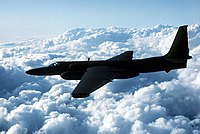
Photo from wikipedia
A near-infrared (NIR) spectrometer was used to test the double-base absorbent powder sample and to quantitatively analyze the contents of each component as well as their dispersion uniformity to establish… Click to show full abstract
A near-infrared (NIR) spectrometer was used to test the double-base absorbent powder sample and to quantitatively analyze the contents of each component as well as their dispersion uniformity to establish a rapid quantitative test method for blending uniformity of modified double-base (MDB) propellant components. First, the quantitative calibration models of hexahydro-1,3,5-trinitro-1,3,5-triazine (RDX) were constructed based on sample testing, and the RDX model’s correlation coefficient was 0.9929. Then, during the blending process, NIR spectra were continually collected. For the original spectra of samples, the blend uniformity was assessed using the coefficient of moving block standard deviation (MBSD). After 160 min, the sample’s MBSD value had reached a steady state of less than 0.003, indicating that the sample’s components were distributed uniformly. The findings reveal that NIR spectroscopy can be used to verify the blending uniformity of MDB propellant components.
Journal Title: ACS Omega
Year Published: 2022
Link to full text (if available)
Share on Social Media: Sign Up to like & get
recommendations!